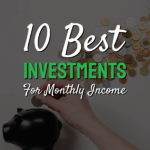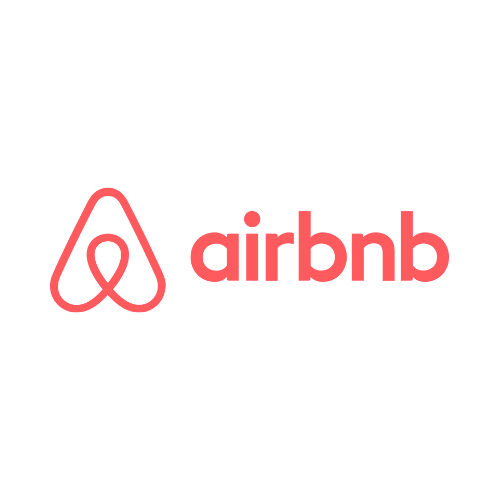10 Investments for Monthly Income
Some products in this article are from our partners. Read our Advertiser Discloser.
Wouldn’t it be great to find investments that earn income every month that could eventually replace your paycheck?
While the following investments have different risk levels and give you exposure to other asset classes, their one common trait is that they can help you earn a monthly income.
Top Investments for Monthly Income
These investing ideas can help you earn recurring income. Some options are riskier than others, each with a different income potential.
As always, it’s important to diversify your portfolio and invest in assets that fit your risk tolerance.
1. Dividend Stocks
Target annual yield: 1.5% to 5%
Stocks can make investors money in two ways. The first and most commonly known method is appreciating share prices. The second is dividend income.
Dividend income is when a company you own stock in has extra profits and, as a result, you receive a cash payment.
There are several ways to earn dividend income, including:
- Dividend-focused index funds
- Individual stocks
- Real estate investment trusts (REITs)
- Mutual funds
Many mutual funds and index funds pay at least one dividend payment per year.
Not every stock pays dividends, but many well-established “blue-chip stocks” pay quarterly dividends. Investors may buy individual dividend stocks to earn dividend income each month.
You can reinvest your dividends to buy additional shares of the same stock with a dividend reinvestment plan. A second option is to live off the dividends if your portfolio is large enough.
Tracking your dividend income and net worth can be difficult as your portfolio expands. You can use The Dividend Tracker to monitor your net worth and investments for free.
Creating a Monthly Dividend Portfolio
Each company pays dividends in different months. As a result, you will need to hold several stocks to earn at least one dividend payment each month.
One model portfolio could include these three stocks:
- Nike (NKE): January, April, July, and October
- Starbucks (SBUX): February, May, August and November
- Visa (V): March, June, September, and December
Even though each company pays quarterly dividends, you’ll receive a dividend payment each month of the year with a portfolio like this.
As always, perform your due diligence and research stocks before investing.
2. Certificate of Deposits
Target annual yield: 4.90%
Bank certificates of deposits (CDs) can earn more than high-yield savings accounts since you invest your cash for a specific number of months. An early redemption means you forfeit several months of interest income.
Most CDs let you either receive monthly interest payments or get the full amount at the end of the investment term.
As interest rates can fluctuate, building a CD ladder lets you capture the best current rates. Your ladder can have staggered maturity dates so you can diversify your interest yields.
CDs can be a low-risk investment and are FDIC-insured. However, you should only invest cash you don’t need instant access to during the CD term.
Banks do offer no-penalty CDs. These don’t have an early redemption penalty, but they do have a lower yield than term CDs.
The minimum investment varies by bank. Several banks have a $0 minimum, but others may require at least $500 or more.
3. High-Yield Savings Accounts
Target annual yield: 4.65%
A high-yield savings account can earn a higher interest rate than a traditional savings account. You can also make penalty-free withdrawals.
Most high-yield accounts don’t require a minimum initial deposit or an ongoing balance. Also, the accounts don’t charge a monthly service fee like a typical brick-and-mortar bank.
There are some caveats that regular savings accounts don’t have. For example, the account might be online-only and only permit up to six monthly withdrawals.
Despite these limitations, high-interest bank accounts are one of the best short-term investments to store cash.
If you are looking for a bank paying 16x the national average, check out CIT Bank, which has a Savings Connect account with higher interest than traditional banks.
4. Bond Index Funds
Target annual yield: 0.10% to 3.30%
Investment-grade corporate and government bonds are a staple fixed-income investment. Bonds have lower growth potential than stocks but are more likely to earn recurring income.
Index funds, which you buy in your 401k or with an investing app, can be the easiest way to invest in bonds.
Most bond index funds are for investment-grade corporations and government bonds. These are widely traded and can be less risky than “junk bonds” or foreign bonds with lower credit ratings but higher potential yields.
One example of a bond index fund is the Vanguard Total Bond Market ETF (BND). This fund lets investors get exposure to U.S. Treasury bonds and investment-grade U.S. corporate bonds.
If you want to invest outside the United States, some funds invest in international bonds.
Other funds focus on holding bonds with different maturity dates, such as 10 years or 20 years. Longer-term bonds typically have higher yields than short-term bonds.
Bond index funds can be an important part of a Boglehead three-fund portfolio. One downside of bond funds is that the share price and yield rate can fluctuate.
Investors with lots of disposable cash can buy individual bonds. These bonds may have a minimum investment of $50,000 per position but can have higher yields than a bond index fund.
5. Small Business Bonds
Target annual yield: 7%
Small business bonds are too small for bond funds to invest in, but they can earn a steady income for individual investors.
Worthy Bonds offers small business bonds with a $10 minimum investment and a 5.5% annual yield. Notes mature after 36 months, but you can sell your shares early with no early redemption penalty.
Since these bonds are riskier than corporate and government bonds, they pay a higher annual yield. Small businesses borrow at a higher rate, and you earn 7% of the interest income.
You may consider these bonds instead of non-investment-grade “junk bonds” that can have competitive yields.
While small business bonds are collateral-backed, it’s possible to lose your investment balance if the borrower defaults.
6. Crowdfunded Real Estate
Target annual return: 6% to 12%
Crowdfunded real estate lets you earn passive income from multifamily apartments and commercial real estate. You invest in public, non-traded projects that require a multi-year investment commitment.
This real estate investing idea can earn higher returns than a REIT or real estate index fund that you can buy with an investing app.
Crowdfund real estate also doesn’t have variable share prices like REITs trading on the stock market. Better yet, you don’t have to self-manage the property as if you own rental real estate.
Most platforms have a minimum five-year investment period. On top of that, selling your shares can take several months since real estate is an illiquid asset.
Your potential annual returns depend on whether the investment has a debt or equity debt structure. Investors can expect annual returns between 6% and 12%, depending on the structure.
Debt Real Estate
Debt-structured deals are more likely to earn monthly income and are less risky. Most debt REITs annual returns are between 6% and 8% and pay quarterly dividends.
Investors make money by collecting interest payments from borrowers and monthly rental income.
Fundrise lets accredited and non-accredited investors get access to crowdfunding real estate with a $10 minimum investment. You can reinvest your dividends or receive a quarterly cash distribution.
The minimum investment period is five years to avoid an early redemption penalty.
Equity Real Estate
Equity deals have higher growth potential and earn most of the investment at the end of the investment term. The fund management team sells properties at a higher value, resulting in an average annual return as high as 12%.
Investors may also earn a small dividend from interest payments or monthly rental income until the property sells.
7. Single-Family Rental Property
Target annual return: 4% and 10%
Buying rental property can be another way to earn passive income by collecting monthly rent. Crowdfunding platforms usually won’t invest in single-family rental homes because there are fewer tenants per property.
That said, owning a rental property can be better than crowdfund real estate since you can invest locally or out of state. You can also earn more income and flexibility as you own the entire property.
Remember that you need to screen tenants and handle property maintenance unless you hire a property manager.
Finding local rental properties is possible by hiring a real estate agent. If your local market isn’t profitable, another option is using Roofstock. This site lists properties for sale across the United States.
Real estate investors call your net profit your “cap rate.” Most cap rates are between 4% and 10%, which is your annual investment return after all expenses.
Discover other ways to invest in real estate and make recurring income.
8. Be an Airbnb Host
Target annual return: 8% to 12%
Having long-term tenants as a landlord isn’t an exciting option for all investors. You might be able to make more money or avoid stress by being an Airbnb host.
Vacation rental homes are becoming more popular than hotels because of the extra privacy. You can make extra money by renting a spare room or a second house.
Entering your property details on the Airbnb website lets you estimate your monthly income. For example, Airbnb estimates an entire house can earn up to $2,000 per month in Orlando, Florida.
Unlike owning a long-term rental, you can designate which days you’re available to accept guests. This scheduling flexibility could be worth it if you can earn more renting to vacationers than tenants.
9. Peer-to-Peer Investing
Target annual return: 3% to 8%
Lending money directly to others with peer-to-peer lending lets you earn monthly passive income. You can buy notes for a three-year or five-year personal loan. The borrower makes interest payments every month.
Prosper lets you buy $25 notes in peer loans. According to the platform, the historical average annual return is 5.4% after fees and defaults.
Investors can invest in loans with higher or lower risk ratings. Higher risk ratings have higher potential yields.
You lose the remaining investment balance if the borrower defaults on their loan. All peer-to-peer loans are unsecured and not backed by collateral.
10. Royalties
Target annual yield: 5% to 20%
Owning royalty rights is another unique way to generate monthly income.
Buying the publishing rights to new and old music and movies is possible. You can self-publish your content or purchase the rights from another artist or royalty holder.
Some of the royalties you can buy include:
- Songs or music albums
- Movies and TV shows
- Books
- Educational material
- Trademarks
Royalty Exchange has auction listings for royalty deals. You can earn royalty income each time someone uses your product or service.
Anyone can invest in royalties, but auctions can be expensive. Auctions may require you to invest $100,000 or more to buy the copyright to well-known songs and movies.
Before bidding, compare the recent royalty income to the potential purchase price. You will need to determine how long you’re willing to wait to pay off the original investment and earn a profit.
An enormous risk is that the royalty income decreases sharply. One example is if a streaming app no longer offers a certain song or movie in its catalog.
Why Invest For Passive Income That Pays Monthly?
As you can tell, there are several ways you can get passive income each month. Here are some of the main reasons you should invest in one of these options
Makes Paying Bills Easier
The main reason why you would choose an option that pays monthly is that most of our regular bills are monthly.
When you choose an investment that pays monthly, you can budget for your everyday bills and pay them on time.
You Can Live Anywhere
When you have investments that provide passive income, you are not tied to a specific location. Rather, you can live from anywhere in the world.
Now, it is important to consider the tax implications of living in different countries because some countries have higher taxes than others.
How Investments That Pay Monthly Compare
Check out how much monthly income you could receive if you invested $100,000 in each investment below.
| Investment | Max % | Monthly Amount |
| Dividends | 5.0% | $416.67 |
| Certificate of Deposit | 4.90% | $408.33 |
| Savings Account | 4.65% | $387.50 |
| Bond Index Fund | 3.3% | $275 |
| Small Business Bonds | 5.0% | $416.67 |
| Crowdfunded Real Estate | 12% | $1,000.00 |
| Rental Property | 10% | $833.33 |
| Airbnb | 12% | $1,000.00 |
| Peer-to-peer | 8.0% | $666.67 |
| Royalties | 20% | $1666.67 |
Frequently Asked Questions
Before investing to earn monthly income, it’s important to understand the potential risks and rewards. These frequently asked questions can help.
The best way to earn a monthly income is different for each investor. You will need to determine your risk tolerance, investment goals and budget.
Bonds, dividend stocks and high-yield cash accounts are the most popular options because of the small investment minimums and relatively low risk.
However, real estate can be a better option for investors with a multi-year investment horizon and a higher cash balance. Real estate can also be less volatile than stocks and bonds with fluctuating share price values.
Yes, it is possible to earn monthly passive income by investing in stocks,
bonds, etc.
Some investments naturally pay monthly dividend income. Others may pay on a quarterly or annual basis.
All investments have some risk, but high-yield savings or money market accounts can be the least risky.
These interest-bearing bank accounts usually have FDIC insurance up to $250,000 per account. Similar credit union accounts offer up to $250,000 in NCUA coverage.
However, safety comes at a price. Interest-bearing bank accounts have some of the lowest interest rates, so your monthly income won’t be as high.
Some of the riskiest income-producing assets can include stocks, small business bonds and even peer-to-peer loans.
Peer-to-peer loans can be the riskiest because you lend money to an individual borrower with an unsecured personal loan. The lender can’t collect collateral to offset the remaining loan balance.
Small business bonds can be riskier than corporate or government bonds since small businesses tend to have fewer cash reserves and lower credit ratings.
Summary
Investing to earn monthly income can be relatively easy. Depending on the investment, it may only require a small amount of cash to get started.
Don’t forget to do your research before investing. While no investment is risk-free, investing in several ideas gives you multiple ways to earn dividends and reduce risk.




